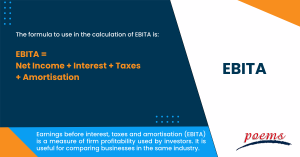EBITA
Table of Contents
EBITA
Metrics, budgets, and planning are essential components of owning a business. Even the most rewarding aspects of running a business, like marketing, advertising campaigns, or increasing client loyalty, revolve around numbers. Earnings before interest, taxes, amortisation, or EBITA for short, is one indicator that fully explains your profitability. When determining profitability before investing, investors look at EBITA as measuring a firm’s effectiveness, profit-making ability, and potential. As a result, the meaning of EBITA is crucial when making forecasts about a company.
What is EBITA?
Earnings before interest, taxes and amortisation (EBITA) is a measure of firm profitability used by investors. It is useful for comparing businesses in the same industry.
Some analysts and investors believe a company’s EBITA indicate its true earnings. It eliminates the effects of taxes owing, interest on corporate debt, and amortisation, which is the accounting technique of deducting the cost of an intangible asset over several years.
Understanding EBITA
EBITDA displays the business’s financial performance without accounting for a company’s capital investments, such as its plant, property, and equipment. Additionally, it does not consider debt-related expenses and focuses more on the business’ operational choices.
These arguments highlight the possibility that it is not a reliable indicator of profitability. Furthermore, it’s frequently used to cover up bad financial decisions like taking out a high-interest loan or utilising depreciating equipment with a high replacement cost. But it is still regarded as a crucial financial metric, nevertheless as it accurately shows a company’s earnings before financial deductions or account adjustments.

Calculation of EBITA
The formula to use in the calculation of EBITA is:
EBITA = Net Income + Interest + Taxes + Amortisation
Where,
- Net income, also known as earnings, is the amount that remains for your business after deducting all costs from your total revenue.
- Interest explains how a company pays for each item, including interest rates from loans from banks or other lenders when calculating interest expenses.
- Taxes are generally location-based because each jurisdiction has laws and regulations governing tax expenses and requirements.
- Amortisation is another non-cash item representing the cost of intangible assets you write down gradually throughout their useful life.
Significance of EBITA
When the effects of taxes, interest, and amortisation are taken out, the true performance of a company’s operations is found. Investors believe that EBITA is a crucial metric to use in determining a company’s actual earnings because the impact of such things is disregarded. Either a positive or negative EBITA value is possible.
A positive EBITA value demonstrates a company’s operational effectiveness and available cash flow to pay dividends or reinvest in business expansion. An unacceptable EBITA shows the company may be having difficulties controlling its cash flow or turning a profit.
The EBITA statistic makes it easier to compare the operational achievements of diverse businesses. As EBITA describes a company’s real earnings, which reflects its capacity to pay its debts, lenders can use EBITA data to assess its creditworthiness.
A high EBITA figure is crucial for a company but should also result in a high net income figure. A company’s future net income is negatively impacted if it takes on debt to expand its operations. So, monitoring the company’s rising EBITA may offer a peek at what lies ahead once the loans are settled.
Example of EBITA
The following example will help you better understand the idea of EBITA. Let us look a a company that wants to know how well it did the previous year. The company had a US$100 million income, and its cost of goods sold, which included the cost of the product plus labour, was US$40 million.
Also, it had US$20 million in overheads. Its operational profit was US$30 million after deducting amortisation costs of US$10 million. The interest accrued was US$5 million, leaving US$25 million in earnings before taxes. The net income was US$21 million after deducting taxes of US$4 million.
EBITA = Net income + interest + taxes + amortisation
= US$21,000,000 + 5,000,000 + 4,000,000 + 10,000,00 = 40,000,000
EBITA = Operational profit + amortisation
= US$30,000,000 + 10,000,000 = 40,000,000
Frequently Asked Questions
EBITDA measures a company’s earnings before interest, taxes, depreciation, and amortisation. It is often used as a proxy for a company’s cash flow and is a popular investor metric. The formula for this is EBITDA = depreciation + amortisation + operating income.
EBIT and EBITDA are both measures of a business’s profitability. Earnings before interest and taxes are referred to as EBIT. Moreover, EBITDA excludes amortisation and depreciation. EBIT, sometimes similar to the GAAP number operating income, is frequently used to measure operating profit.
After all Selling, General and Administrative (SG&A) costs, depreciation and amortisation, a company’s EBITA may be found in the income statement.
The underlying profitability of the companies may be tracked and compared using EBITDA, regardless of the depreciation assumptions or financing methods employed by the companies.
EBITDA is a helpful metric for investors, but it is important to understand its limitations. EBITDA can give investors a clear picture of a company’s financial health when used with other financial measures.
It is important to remember that EBITDA is a measure of earnings, not cash flow. EBITDA does not account for all forms of capital expenditure, such as property, plant, and equipment investments. Thus, management can manipulate it through accounting techniques such as aggressive depreciation.
EBITDA comprises the following components:
- Earnings, also known as net income, are the sum of a company’s profits over a specific period, typically a quarter or year.
- The cost of having debt is the interest payments. Most debt and financing arrangements include interest and principal payments.
- Local, state, and federal taxes on things like income and property are all included in a company’s total taxes.
- Assets’ worth gradually declines over time, and the initial cost of the asset being written off is represented by depreciation and amortisation. Intangible assets like copyrights or patents are subject to amortisation, while tangible assets like machinery or structures typically experience depreciation.
Related Terms
- Trailing Stops
- Exchange Control
- Relevant Cost
- Dow Theory
- Hyperdeflation
- Hope Credit
- Futures contracts
- Human capital
- Subrogation
- Qualifying Annuity
- Strategic Alliance
- Probate Court
- Procurement
- Holding company
- Harmonic mean
- Trailing Stops
- Exchange Control
- Relevant Cost
- Dow Theory
- Hyperdeflation
- Hope Credit
- Futures contracts
- Human capital
- Subrogation
- Qualifying Annuity
- Strategic Alliance
- Probate Court
- Procurement
- Holding company
- Harmonic mean
- Income protection insurance
- Recession
- Savings Ratios
- Pump and dump
- Total Debt Servicing Ratio
- Debt to Asset Ratio
- Liquid Assets to Net Worth Ratio
- Liquidity Ratio
- Personal financial ratios
- T-bills
- Payroll deduction plan
- Operating expenses
- Demand elasticity
- Deferred compensation
- Conflict theory
- Acid-test ratio
- Withholding Tax
- Benchmark index
- Double Taxation Relief
- Debtor Risk
- Securitization
- Yield on Distribution
- Currency Swap
- Overcollateralization
- Efficient Frontier
- Listing Rules
- Green Shoe Options
- Accrued Interest
- Market Order
- Accrued Expenses
- Target Leverage Ratio
- Acceptance Credit
- Balloon Interest
- Abridged Prospectus
- Data Tagging
- Perpetuity
- Hybrid annuity
- Investor fallout
- Intermediated market
- Information-less trades
- Back Months
- Adjusted Futures Price
- Expected maturity date
- Excess spread
- Quantitative tightening
- Accreted Value
- Equity Clawback
- Soft Dollar Broker
- Stagnation
- Replenishment
- Decoupling
- Holding period
- Regression analysis
- Wealth manager
- Financial plan
- Adequacy of coverage
- Actual market
- Credit risk
- Insurance
- Financial independence
- Annual report
- Financial management
- Ageing schedule
- Global indices
- Folio number
- Accrual basis
- Liquidity risk
- Quick Ratio
- Unearned Income
- Sustainability
- Value at Risk
- Vertical Financial Analysis
- Residual maturity
- Operating Margin
- Trust deed
- Leverage
- Profit and Loss Statement
- Junior Market
- Affinity fraud
- Base currency
- Working capital
- Individual Savings Account
- Redemption yield
- Net profit margin
- Fringe benefits
- Fiscal policy
- Escrow
- Externality
- Multi-level marketing
- Joint tenancy
- Liquidity coverage ratio
- Hurdle rate
- Kiddie tax
- Giffen Goods
- Keynesian economics
- Risk Tolerance
- Disbursement
- Bayes’ Theorem
- Amalgamation
- Adverse selection
- Contribution Margin
- Accounting Equation
- Value chain
- Gross Income
- Net present value
- Liability
- Leverage ratio
- Inventory turnover
- Gross margin
- Collateral
- Being Bearish
- Being Bullish
- Commodity
- Exchange rate
- Basis point
- Inception date
- Riskometer
- Trigger Option
- Zeta model
- Racketeering
- Market Indexes
- Short Selling
- Quartile rank
- Defeasance
- Cut-off-time
- Business-to-Consumer
- Bankruptcy
- Acquisition
- Turnover Ratio
- Indexation
- Fiduciary responsibility
- Benchmark
- Pegging
- Illiquidity
- Backwardation
- Backup Withholding
- Buyout
- Beneficial owner
- Contingent deferred sales charge
- Exchange privilege
- Asset allocation
- Maturity distribution
- Letter of Intent
- Emerging Markets
- Consensus Estimate
- Cash Settlement
- Cash Flow
- Capital Lease Obligations
- Book-to-Bill-Ratio
- Capital Gains or Losses
- Balance Sheet
- Capital Lease
Most Popular Terms
Other Terms
- Physical ETF
- Initial Public Offering
- Buyback
- Secondary Sharing
- Bookrunner
- Notional amount
- Negative convexity
- Jumbo pools
- Inverse floater
- Forward Swap
- Underwriting risk
- Reinvestment risk
- Final Maturity Date
- Payment Date
- Secondary Market
- Margin Requirement
- Mark-to-market
- Pledged Asset
- Yield Pickup
- Subordinated Debt
- Treasury Stock Method
- Stochastic Oscillator
- Bullet Bonds
- Basket Trade
- Contrarian Strategy
- Notional Value
- Speculation
- Stub
- Trading Volume
- Going Long
- Pink sheet stocks
- Rand cost averaging
- Sustainable investment
- Stop-limit sell order
- Economic Bubble
- Ask Price
- Constant prepayment rate
- Covenants
- Stock symbol
- Companion tranche
- Synthetic replication
- Bourse
- Beneficiary
- Witching Hour
- Widow and Orphan stock
- Public Float
- Closing Price
- Reverse stock splits
- Quiet period
- Prepayment risk
Know More about
Tools/Educational Resources
Markets Offered by POEMS
Read the Latest Market Journal

Back in Business: The Return of IPOs & Top Traded Counters in March 2024
Start trading on POEMS! Open a free account here! At a glance: Major indices continue...

Weekly Updates 15/4/24 – 19/4/24
This weekly update is designed to help you stay informed and relate economic and company...

From $50 to $100: Unveiling the Impact of Inflation
In recent years, inflation has become a hot topic, evoking strong emotions as the cost...

Japan’s Economic Resurgence: Unveiling the Tailwinds Behind Nikkei 225’s Record Leap
Source: eSignal, Intercontinental Exchange, Inc. In the heart of Japan’s economic landscape, the Nikkei 225...

Weekly Updates 8/4/24 – 12/4/24
This weekly update is designed to help you stay informed and relate economic and...

What Makes Forex Trading Attractive?
In a world where the click of a button can send goods across oceans and...

Weekly Updates 1/4/24 – 5/4/24
This weekly update is designed to help you stay informed and relate economic and company...

How to soar higher with Positive Carry!
As US Fed interest rates are predicted to rise 6 times this year, it’s best...


















